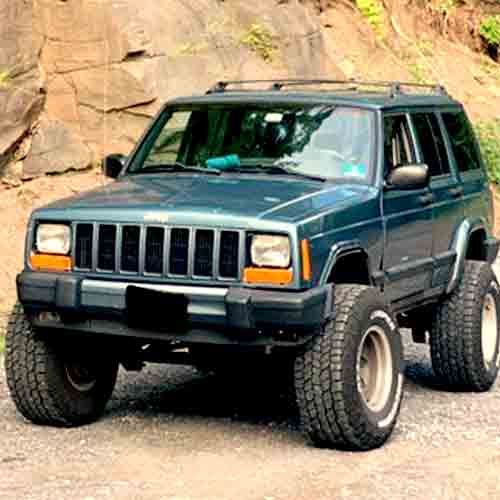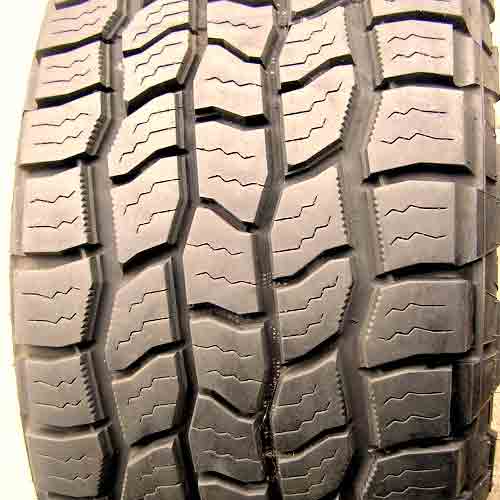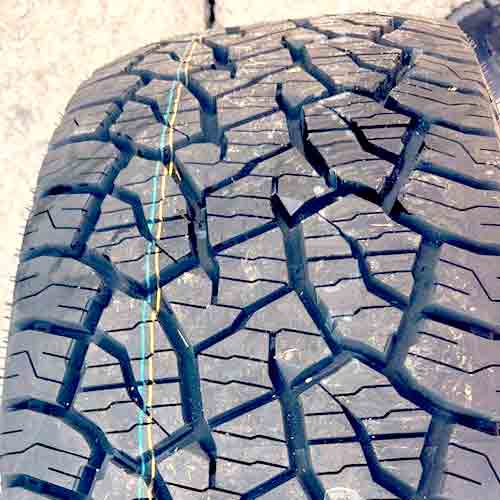Both Kumho Road Venture AT52 and the Cooper Discoverer AT3 XLT are great all-terrain options, suitable for all types of tracks, doesn’t matter if it’s off-road beaten paths or the daily commute. Moreover, with all season compound, they also do great with their thermal adaptive rubber providing traction even even on snowy terrains. Though, it often requires lots of time and effort to make the right decision, when it comes to these two, so let me save you some of that.

In my expert opinion as a tire engineer, the Cooper AT3 is a better tire if you want off-road traction, wet on-road performance, and a great tread life. Whereas the Kumho AT52 does better on winter terrains, dry on-road grip, and fuel efficiency.
Tread Design
Starting with Cooper Discoverer AT3, from the middle…

Here the central most lugs are slightly wider, though they carry similar tread features like the rest, well, except for snow vices.
(These snow vices (the toothed edges), basically help a lot in grabbing snow particles, as you’d see in the winter performance section).
All lugs are seen with full depth interlocking sipes and have reinforced foundations, other than that, and that also goes for shoulders.
The shoulder lugs carry connectors in between, have snow vices towards inner sides, and on the outer, they have mud scoops and thicker sidewall lugs to provide off-road traction (with lowered air PSI).
For Your Info: The sidewall lugs are the main features which differentiates the Cooper AT3 XLT, from the Discoverer LT and the Discoverer 4S.
Moving on towards the other tire, the Kumho Road Venture AT52 although feature more biters, they still give out an on-road oriented pattern. Let me explain how.

So looking at things here form the middle, first, the tire provides a symmetric tread design consisting of 3 main ribs.
The middle most have U shaped lugs, but as they are joined up with each other (from underneath), consider them as a whole “S” shaped blocks.
Same is the case with surrounding ribs, they may seem divided up, they are sitting on a secondary rubber layer underneath, acting as reinforced foundations.
These make the lugs stable on roads, where the in-groove notches and multiple biters they make yield ample traction on all types of rugged terrains.
Though shoulder lugs could have improved a little bit, as they are not aggressive enough, carrying rectilinear sipes, and no staggered outer edges.
Nonetheless, in comparison, you do get sidewall lugs of same thickness as of Cooper AT3.
Tire Sizes
The Cooper Discoverer AT3 XLT comes in 15 to 20 inches rims.
- They have speed ratings of either R or S
- Load range: C to F
- Weight range: 44 lbs to 70 lbs
- Tread depth: 16.5 or 17/32
- Warranty: 60,000 miles
The Kumho Road Venture AT52 provides you with 15 to 20 inches rim diameters with following specs:
- Speed ratings: Q, R, S and T.
- Load ratings: SL, XL, C, D, E and F.
- Weight range: 30 to 63 lbs.
- Tread depth: 13 to 16/32″ (mostly seen with 16/32″).
- Ratings: 3PMSF and M+S rated.
- Warranty: 50k miles for LT, and 55k for P metric sizes.
Read tire size: https://tiredriver.com/how-to-read-tire-size/
Internal Construction
In order to function effectively on “puncturing” terrains, when exposed to sharp objects, the durability of off-road tires is a critical consideration. This is why most of them incorporate cut-resistant rubber and deep tread voids. But that only gives a tire 20% durability.
So where does the rest of it comes from?
Well internal construction, and to even put it more specifically, internal built of sidewalls.
That’s why both tires show up with similar durability overall, they both have 2 ply reinforced casing with 2 steel belts and a single cap ply of nylon.
Check out more on –
Are A/T tires harder to puncture: https://tiredriver.com/are-all-terrain-tires-harder-to-puncture/
Highway Traction
In order to get a good understanding of the dry performance, consider traction, steering, and cornering ability, I’ve discussed all of them below one after another.
Directional Grip
The tire’s directional grip is calculated on a straight (dry) road, by determining the braking distances (for the most part). So here the overall tire’s footprint with the ground has a direct relation.
That’s why the Kumho Road Venture AT52 out of both tires, show better results, with it’s more packed up lugs.
Cooper Discoverer AT3 XLT on the other side, although features vertical orientation of lugs, lacks overall with it’s weight and and greater tread depth. Both of these features cause the tire to have a greater momentum, which takes longer to stop. In simpler words its shows longer braking distances (4 feet longer), in comparison.
For Your Info: In my list of top A/T tires, the most effective tire for highways, is Continental TerrainContact A/T (review). The tire is also the quietest, BTW.
Dry Handling
The handling depends on the sidewalls and shoulders, and with a greater footprint offering form Kumho Road Venture AT52, it makes sense why the tire does better here overall.
Cooper Discoverer AT3 XLT on the other hand, not only is able to provide ample contact with the ground form there, it’s weight and softer compound also pushes its lugs to bend more, as the tire corners.
This results in the tire’s over and under steering which impacts the overall fastness of the tire, or in other words, the steering response becomes lowered.
Wet Traction
Optimal wet performance is achieved through effective water removal, leading to improved grip and decreased risk of hydroplaning, the two main factors here, worth talking about. Let’s start with grip.
To ensure a secure grip on wet roads, the tire must have both siping and flexibility. This combination allows for quicker water evacuation from the tire tread, as the sipes “flex” to create a suction, which absorbs water particles coming underneath.
And considering the structure of both tires, it can be seen why the Cooper AT3 provides better abilities. It features interlocking sipes, for one, and it’s tread has more silica in it, making is supple off the two tires.
The interlocking (or wave-like) structure allows for the sipes to stay malleable during corning, braking and acceleration. And the softer tread composition further add to that, allowing siping slits to contract and expand with less energy, rendering superior water wiping abilities.
Kumho Road Venture AT5 on the other side, although lacks at gripping part, it’s hydroplaning performance is better.
The tire features a better interlinked web of grooves, allowing water to have multiple paths to escape out in time. Nonetheless overall, it’s wet traction still takes the back seat, comparatively.
Tread Mileage
Out of both tires, the Kumho AT52 burns faster, even though its a lighter tire here.
So why is that?
Well, because of three things.
- It’s lugs have more biters on them.
- They are not longitudinally oriented.
- And they have shallower tread depth.
The Cooper Discoverer AT3 on the other side, provides less biters, so they don’t create as much rolling resistance (especially on dry roads), and the tire’s vertically aligned lugs just produces better efficacy, as the tire rolls straight, creating less wastage in to fictional forces.
Moreover, with it’s greater tread depth (on average), it takes more time for it to comes down to 2/32″.
That’s why Cooper AT3 gives you 10k more miles warranty, whereas the Kumho Road Venture gives 50k miles (for LT, and 55k for P metric sizes).
On-Road Noise
Unwanted noise is a result of the flow of air, primarily through the shoulder grooves of the tire’s tread. And as the Kumho Road Venture AT52 features a very streamlined shoulder grooves, connecting the ones seen on the following ribs, it’s able to dampen the noise in a better way.
Furthermore, with less tread depth, the tire also generated limited groove resonance, whereas on Cooper AT3 with a larger tread depth, the air particles have more area to bounce off, and create echo, limiting it’s noise dampening abilities.
This basically has to do with pitch sequencing, I discussed it more in my post of, all-terrain tires and noise.
Winter Traction
The many factors that influence winter traction include grip, acceleration, lateral traction, stability, and the tire’s ability to perform on different snow and ice terrains.
And considering all, the Kumho Road Venture AT52 shows a better traction abilities, even though both tires are branded with 3 peak mountain snowflake rating.
This is because this tire provides better snow holding abilities with it’s interconnected tread voids and in-groove biters (as well, as sipes). They hold the snowy surface in a better way and make snow to snow contact with it.
Cooper Discoverer AT3 XLT on the other side, although features snow vices (toothed-edges) on it’s outer circumferential grooves, the tire’s overall less biting structure with squared off lugs, can’t supply enough snow picking.
This is significant, because this type of contact yields better friction compared to snow to rubber contact.
Off Road Performance
Some off-road terrains, like mud, can be difficult to handle and specialized tires may be needed, while others, like gravel and dirt roads, are much easier to navigate. That’s why I’ve chosen to discuss each terrain separately.
On Mud
Although both tires are pretty packed up, you still see a superior mud performance on Cooper AT3.
This is because it offers staggered outer edges (on the shoulders), and this combined with its sidewall lugs, you get superior scooping on the mud, which throws back thick clay, and moves the tire forward, as a result.
Kumho Road Venture AT52 on the other side, despite forming multiple channels with it’s interconnected central tread voids, still lacks due to it’s less aggressive outer edges, and sidewalls.
That’s why mud terrain tires having both, balder structures, and outer scoops provide better traction, comparatively.
Sand Performance
When driving on sand, lowering your tire’s air pressure is a critical step. This results in a “floating” effect and improved performance on soft surfaces. Though affecting this are some tires features, and those are better provided by Cooper Discoverer AT3 XLT, let me explain why.
So this tire features, comes with thicker sidewalls with lugs that are capable of spreading over a larger surface area, enhancing flotation of the tire.
Kumho Road Venture AT52, on the other side, although gets to be lighter in weight, it’s sharper sides are still more prone to dig more, comparatively. So it’s overall traction takes the back seat here.
Good Read –
Are All-Terrain Tires Good On Sand? : https://tiredriver.com/are-all-terrain-tires-good-on-sand/
Rocky Tracks
In order to drive safely on rocky terrains, it is important to have a tire with a tread that provides traction in all direction along with effective sidewalls.
That’s why here Cooper AT3 takes the larger piece of the pie, with it’s more effective features. The tire although has similar durability compared to it’s counterpart, it’s thick sidewall lugs and staggered shoulder account for a majority of tire’s traction (with lowered air pressure), during the climb.
Kumho Road Venture AT52, on the other side, although has better biting abilities form the middle (area of the tread), the tire’s overall traction is still not good enough comparatively.
Take Home Points
So overall, keep in mind that, if you are mostly traveling on wet roads, you should consider Cooper AT3 here. The tire would also provide superior tread life, and is better off-road here in comparison.
The Kumho AT52 on the other side, is great when it comes to winter traction, dry traction, and fuel efficiency.